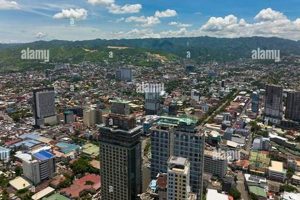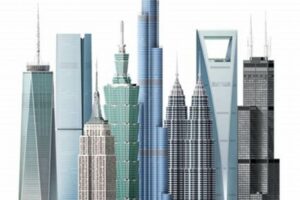Wooden skyscrapers are high-rise buildings primarily constructed using wood as the main structural material. These structures have gained significant attention in recent years due to their sustainability, durability, and design flexibility.
The use of wood in skyscrapers offers several advantages. Wood is a renewable resource, making it an environmentally friendly building material. It is also lightweight, strong, and has excellent insulation properties. Additionally, wood is relatively easy to work with, allowing for innovative and complex architectural designs. Historically, wooden skyscrapers have been limited in height due to fire safety concerns. However, advancements in fire-resistant treatments and engineering techniques have enabled the construction of taller wooden buildings.
The exploration of wooden skyscrapers is a promising area in architecture and construction. As technology continues to advance, we can expect to see even more innovative and sustainable wooden high-rise buildings in the future.
1. Sustainable
Sustainability is a key aspect of wooden skyscrapers, as wood is a renewable resource that has a lower environmental impact compared to traditional building materials such as concrete and steel. Wooden skyscrapers can help to reduce greenhouse gas emissions, deforestation, and pollution.
- Carbon Sequestration
Wood naturally sequesters carbon dioxide from the atmosphere. By using wood in construction, we can help to reduce the amount of greenhouse gases in the environment.
- Reduced Deforestation
The use of wood in construction can help to reduce deforestation, as it is a renewable resource that can be grown and harvested sustainably.
- Lower Embodied Energy
The production of wood requires less energy compared to other building materials such as concrete and steel. This results in lower embodied energy for wooden skyscrapers.
- Improved Air Quality
Wood naturally helps to improve air quality by absorbing pollutants and releasing oxygen.
Overall, the use of wood in skyscrapers can help to promote sustainability and reduce the environmental impact of the construction industry.
2. Durable
Durability is a crucial aspect of wooden skyscrapers, as these structures are designed to withstand various environmental and structural challenges over an extended lifespan.
- Resistance to decay and pests
Wood naturally resists decay and pests due to its inherent chemical composition and cellular structure. This characteristic contributes to the longevity of wooden skyscrapers, reducing maintenance costs and ensuring structural integrity over time.
- Fire resistance
Advancements in fire-resistant treatments and engineering techniques have significantly improved the fire resistance of wood. Wooden skyscrapers are equipped with fire-retardant materials and structural systems that can withstand fires for extended periods, ensuring the safety of occupants and the integrity of the building.
- Structural strength
Wood is a surprisingly strong and versatile building material. Modern construction techniques, such as cross-laminated timber (CLT) and nail-laminated timber (NLT), enhance the structural strength of wood, enabling the construction of tall and resilient wooden skyscrapers that can withstand high winds and seismic activity.
- Seismic resilience
The inherent flexibility of wood makes it well-suited for seismic regions. Wooden skyscrapers are designed to sway and absorb seismic energy during earthquakes, reducing structural damage and maintaining the integrity of the building.
These facets of durability make wooden skyscrapers a viable and long-lasting solution for modern urban environments. Their ability to withstand environmental challenges and maintain structural integrity over time ensures the safety and longevity of these innovative buildings.
3. Fire-resistant
In the context of wooden skyscrapers, fire resistance is a critical aspect that ensures the safety and integrity of these structures. Historically, wood has been perceived as a combustible material, raising concerns about its suitability for high-rise buildings. However, advancements in fire-resistant treatments and engineering techniques have revolutionized the use of wood in skyscrapers, making them viable and safe for modern urban environments.
To enhance the fire resistance of wooden skyscrapers, architects and engineers employ a range of strategies. One common approach is the use of fire-retardant chemicals that are applied to the wood during construction. These chemicals help to slow down the spread of fire and reduce the risk of ignition. Additionally, wooden skyscrapers are often constructed using mass timber products, such as cross-laminated timber (CLT) and nail-laminated timber (NLT). These products are engineered to provide exceptional fire resistance, as they have a high density and low surface area-to-volume ratio, which makes them less susceptible to ignition and flame spread.
Real-life examples of fire-resistant wooden skyscrapers can be found around the world. The Brock Commons Tallwood House in Vancouver, Canada, is an 18-story student housing building constructed primarily from CLT. This building has been designed to withstand a one-hour fire without collapsing, meeting the stringent fire safety codes of North America. Another notable example is the Treet Tower in Bergen, Norway, which is a 14-story residential building constructed from solid timber. The building’s innovative design incorporates fire-resistant materials and compartmentalization strategies to ensure the safety of its occupants.
Understanding the connection between fire resistance and wooden skyscrapers is crucial for architects, engineers, and policymakers involved in the construction and regulation of these structures. By implementing effective fire-resistant measures, wooden skyscrapers can be designed to meet or exceed the fire safety standards of traditional steel and concrete buildings, making them a viable and sustainable option for urban development.
4. Lightweight
The lightweight nature of wood is a significant advantage in the construction of skyscrapers. Wooden skyscrapers are considerably lighter than traditional steel and concrete buildings, which offers several benefits a
nd implications.
- Reduced Structural Load
The lighter weight of wooden skyscrapers reduces the structural load on the building’s foundation and framework. This allows for more efficient and cost-effective structural designs, as well as the potential for taller buildings with fewer structural supports.
- Faster Construction
The lightweight components of wooden skyscrapers enable faster construction times compared to heavier materials like concrete. This is because wooden components can be prefabricated off-site and then assembled on-site, reducing the time and labor required for construction.
- Seismic Resilience
The lightweight nature of wooden skyscrapers contributes to their seismic resilience. During an earthquake, the lighter weight of the building reduces the inertial forces acting on it, making it less susceptible to structural damage.
- Transportation and Handling
The lightweight components of wooden skyscrapers simplify transportation and handling during construction. Lighter materials are easier to transport and maneuver, reducing the need for heavy machinery and specialized equipment.
In summary, the lightweight nature of wood offers significant advantages for the construction of skyscrapers. It allows for more efficient structural designs, faster construction times, improved seismic resilience, and simplified transportation and handling, making wooden skyscrapers a viable and attractive option for modern urban environments.
5. Cost-effective
The cost-effectiveness of wooden skyscrapers is a significant factor driving their increasing popularity in the construction industry. Wooden skyscrapers offer several advantages that contribute to their cost-effectiveness compared to traditional steel and concrete buildings.
- Material Costs
Wood is generally a more cost-effective material than steel or concrete. This is especially true in regions where wood is abundant and readily available. The use of wood in skyscrapers can lead to significant savings in material costs.
- Construction Costs
The lightweight nature of wood enables faster and more efficient construction methods. Wooden components can be prefabricated off-site and then assembled on-site, reducing labor costs and construction time. This streamlined construction process contributes to overall cost savings.
- Maintenance Costs
Wooden skyscrapers require less maintenance compared to traditional buildings. Wood is naturally resistant to rot and decay, and modern fire-retardant treatments further enhance its durability. These factors reduce the need for ongoing maintenance and repairs, leading to lower lifecycle costs for wooden skyscrapers.
- Environmental Costs
The sustainability of wood as a renewable resource contributes to the cost-effectiveness of wooden skyscrapers. By using wood, we can reduce the environmental impact of construction and potentially qualify for green building certifications. These certifications can provide financial incentives and tax benefits, further enhancing the cost-effectiveness of wooden skyscrapers.
In summary, wooden skyscrapers offer several advantages that make them a cost-effective option for modern urban development. From lower material and construction costs to reduced maintenance and environmental expenses, wooden skyscrapers provide a compelling value proposition for investors, developers, and environmentally conscious individuals alike.
6. Aesthetically pleasing
The pursuit of aesthetically pleasing wooden skyscrapers is not merely a matter of visual appeal but a strategic consideration that encompasses sustainability, functionality, and the overall well-being of building occupants. Wooden skyscrapers offer a unique opportunity for architects and designers to create visually striking structures that harmonize with their surroundings and elevate the urban landscape.
The natural beauty of wood, with its rich textures and warm tones, lends itself to aesthetically pleasing designs. Wooden skyscrapers can exude a sense of warmth and organic elegance, creating a welcoming and inviting atmosphere for residents and visitors alike. Moreover, the versatility of wood allows for innovative architectural expressions, from traditional to contemporary styles, catering to diverse aesthetic preferences.
Beyond visual appeal, the aesthetic qualities of wooden skyscrapers can have a positive impact on occupant well-being. Studies have shown that exposure to natural materials, such as wood, can reduce stress, improve mood, and enhance overall cognitive function. Wooden skyscrapers, with their abundance of exposed wood surfaces, can create interiors that foster a sense of tranquility and connection to nature, contributing to the overall well-being of those who inhabit them.
Examples of aesthetically pleasing wooden skyscrapers can be found around the world. The Vancouver House in Vancouver, Canada, is a striking example of a contemporary wooden skyscraper that seamlessly blends into the city’s skyline. The building’s curved facade, inspired by the surrounding mountains, creates a dynamic and visually appealing form. Another notable example is the Mjstrnet in Brumunddal, Norway, which holds the record for being the tallest wooden building in the world. The tower’s elegant design incorporates traditional Norwegian architectural elements with modern sustainable practices, resulting in a visually stunning and environmentally conscious landmark.
In conclusion, the pursuit of aesthetically pleasing wooden skyscrapers is a multifaceted endeavor that encompasses sustainability, functionality, and occupant well-being. By embracing the natural beauty and versatility of wood, architects and designers can create visually striking structures that enhance the urban landscape and contribute to the overall quality of life for those who live, work, and visit these iconic buildings.
7. Renewable
The concept of “renewable” is inextricably linked to the essence of wooden skyscrapers. Wood, as a natural and sustainable building material, plays a pivotal role in reducing the environmental impact of high-rise construction. Unlike non-renewable resources such as steel and concrete, wood can be replenished through responsible forestry practices, making it a sustainable choice for the future.
The use of renewable materials in skyscrapers has far-reaching implications. By incorporating wood into the construction process, we can significantly reduce greenhouse gas emissions and promote carbon sequestration. Wood naturally absorbs carbon dioxide during its growth, and by utilizing it in construction, we can effectively store carbon within the building structure. This carbon storage potential contributes to mitigating climate change and creating a more sustainable built environment.
Moreover, the renewable nature of wood ensures a steady supply of building materials, reducing reliance on finite resources. Sustainable forestry practices, such as selective logging and reforestation, help maintain he
althy forests while providing a continuous source of wood for construction. This sustainable approach ensures that wooden skyscrapers can be built without compromising the availability of wood for future generations.
Examples of stunning renewable wooden skyscrapers can be found worldwide. The Brock Commons Tallwood House in Vancouver, Canada, is an 18-story student housing building constructed primarily from cross-laminated timber (CLT). This building showcases the structural capabilities of wood and serves as a testament to the viability of tall wooden structures. Another notable example is the Treet Tower in Bergen, Norway, which holds the record for being the tallest wooden building in the world. The tower’s innovative design incorporates sustainable materials and construction methods, demonstrating the potential of wood in achieving architectural excellence.
In conclusion, the connection between “renewable” and “wooden skyscrapers” is a critical aspect of sustainable urban development. By embracing renewable materials like wood, we can create sustainable and resilient buildings that minimize environmental impact, promote carbon sequestration, and ensure a sustainable future for generations to come.
Frequently Asked Questions About Wooden Skyscrapers
Wooden skyscrapers, a relatively new concept in high-rise construction, have sparked curiosity and raised questions. Here are answers to some of the most commonly asked questions about these innovative buildings:
Question 1: Are wooden skyscrapers safe?
Yes, wooden skyscrapers are designed to meet the same safety standards as traditional steel and concrete buildings. Advanced fire-resistant treatments and engineering techniques ensure that wooden skyscrapers can withstand fires and other structural challenges.
Question 2: Are wooden skyscrapers sustainable?
Yes, wooden skyscrapers are considered sustainable because wood is a renewable resource. Wood naturally absorbs carbon dioxide, making these buildings carbon sinks. Additionally, sustainable forestry practices ensure a continuous supply of wood for construction.
Question 3: Are wooden skyscrapers durable?
Yes, wooden skyscrapers are durable and can last for centuries. Wood is naturally resistant to decay and pests, and modern treatments further enhance its durability. Additionally, wooden skyscrapers are designed to withstand high winds and seismic activity.
Question 4: Are wooden skyscrapers cost-effective?
Yes, wooden skyscrapers can be cost-effective compared to traditional buildings. Wood is generally less expensive than steel or concrete, and the lightweight nature of wood reduces structural costs. Additionally, prefabrication and modular construction techniques can further reduce construction time and costs.
Question 5: Are wooden skyscrapers aesthetically pleasing?
Yes, wooden skyscrapers can be visually striking and integrate well with urban landscapes. Wood’s natural beauty and versatility allow for diverse architectural expressions, from traditional to contemporary designs.
Question 6: What are some examples of wooden skyscrapers?
Notable examples of wooden skyscrapers include the Brock Commons Tallwood House in Vancouver, Canada, and the Treet Tower in Bergen, Norway. These buildings showcase the architectural possibilities and sustainability benefits of wooden high-rises.
In summary, wooden skyscrapers are safe, sustainable, durable, cost-effective, and aesthetically pleasing. They offer a viable and innovative solution for sustainable urban development.
Transition to the next article section: Understanding the Environmental Benefits of Wooden Skyscrapers
Tips for Constructing Sustainable Wooden Skyscrapers
The construction of sustainable wooden skyscrapers requires careful planning and implementation. Here are some tips to ensure the successful execution of these innovative building projects:
Tip 1: Choose Sustainable Wood Sources
Select wood from sustainably managed forests that adhere to responsible forestry practices. This ensures that the wood is harvested without compromising the long-term health of the forest ecosystem.
Tip 2: Use Advanced Fire-Resistant Treatments
Implement comprehensive fire-resistant treatments to enhance the safety of wooden skyscrapers. These treatments can include fire retardants, sprinklers, and compartmentalization strategies to prevent the spread of fire.
Tip 3: Design for Structural Stability
Employ robust structural designs that can withstand high winds and seismic activity. Utilize cross-laminated timber (CLT) and nail-laminated timber (NLT) for their exceptional strength and stability.
Tip 4: Optimize Energy Efficiency
Incorporate energy-efficient features such as triple-glazed windows, LED lighting, and smart building management systems to reduce energy consumption and operating costs.
Tip 5: Consider Prefabrication and Modular Construction
Prefabrication and modular construction techniques can streamline the construction process, reduce waste, and improve cost-effectiveness.
Tip 6: Focus on Indoor Environmental Quality
Prioritize indoor environmental quality by using low-emitting materials, providing ample natural ventilation, and incorporating biophilic design elements to enhance occupant well-being.
Tip 7: Collaborate with Experts
Collaborate with experienced architects, engineers, and contractors who specialize in wooden skyscraper construction to ensure the successful execution of the project.
Tip 8: Obtain Necessary Certifications
Pursue green building certifications, such as LEED or BREEAM, to demonstrate the sustainability and energy efficiency of the wooden skyscraper.
By following these tips, developers and construction professionals can create sustainable wooden skyscrapers that meet the highest standards of safety, durability, and environmental performance.
Transition to the article’s conclusion: Embracing Wooden Skyscrapers for a Sustainable Future
Conclusion
The exploration of wooden skyscrapers in this article has illuminated their numerous advantages, including sustainability, durability, cost-effectiveness, and aesthetic appeal. Wooden skyscrapers offer a promising solution for addressing the environmental challenges associated with traditional high-rise construction.
As we strive towards a more sustainable built environment, the adoption of wooden skyscrapers will play a crucial role. These innovative structures not only reduce carbon emissions and promote carbon sequestration but also provide durable and visually striking additions to our urban landscapes. By embracing wooden skyscrapers, we can create cities that are not only resilient but also harmonious with the natural world.







